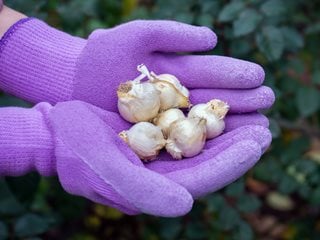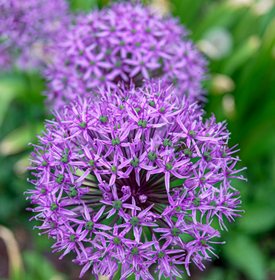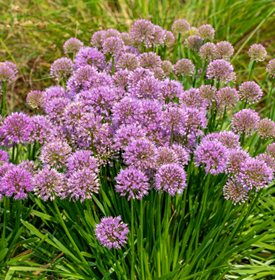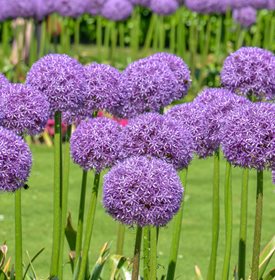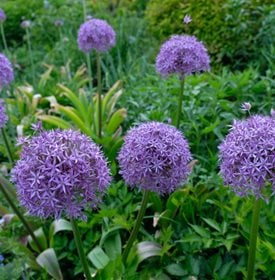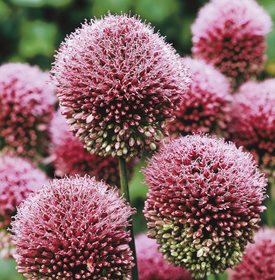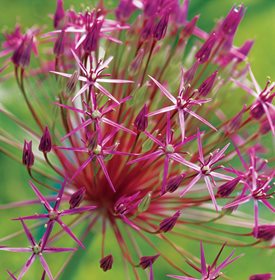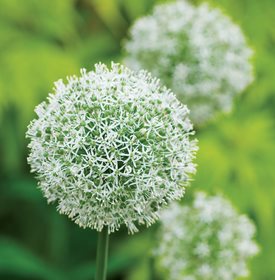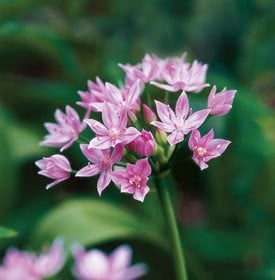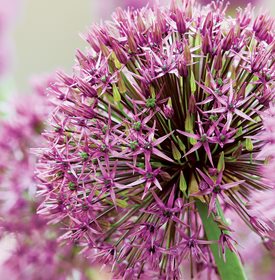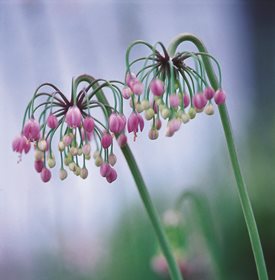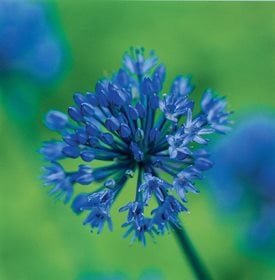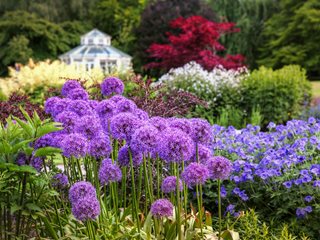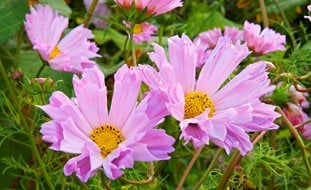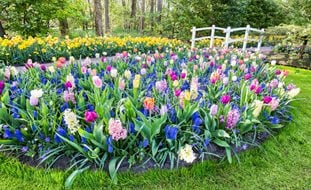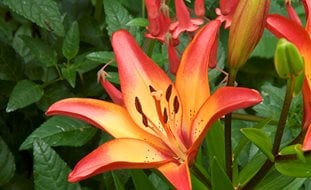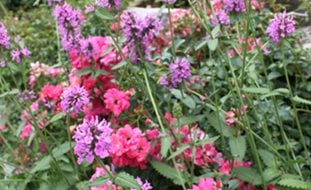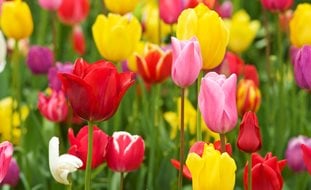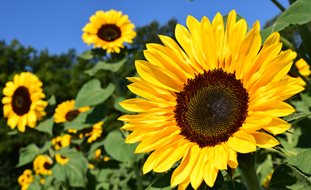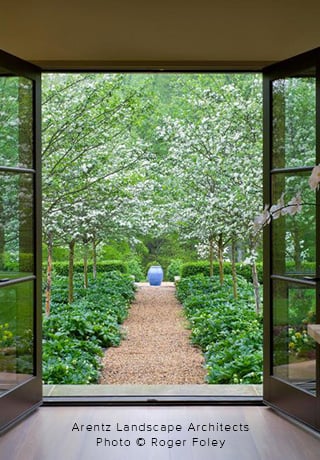Allium Flowers Bring Star Power to the Garden
Stylish, long-lived and easy to grow, allium bulbs are unbeatable for the perennial border
Allium 'Millenium'. Photo by: Barbara Smits / Shutterstock
5 Reasons to Grow Alliums- Pollinator magnet
- Low maintenance
- Drought tolerant
- Deer & rabbit resistant
- Unique multi-season interest
With names like ‘Gladiator’, ‘Goliath’, and ‘Globemaster’, there’s no doubt about the powerful punch ornamental onions can pack. The globe-shaped blooms are comprised of hundreds of densely packed individual flowers. They also make chic pairings with a plethora of other perennials and even lend a touch of humor.
We find killer combinations of qualities in ornamental onions: easy and gorgeous, elegant and playful, dainty and bold, at home in both meadow gardens and formal borders. Perfect “tuck-ins,” they play well with other plants, and return reliably year after year. With lots of colors, heights, and sizes, there are alliums for every garden, small or large. They also make outstanding, long-lasting cut flowers.
On this page: Basics | Planting | Care | Varieties | Design Ideas
On this page:
THE BASICS
Botanical name:
Allium spp. Onions, chives, garlic, and leeks also belong to the genus Allium.
Common names:
Ornamental onion
Zones:
3-8, depending on variety
Height/spread:
12 to 36 inches tall, 3 to 18 inches wide, depending on variety
Exposure:
Most prefer full sun—even part shade will make them lean over, reaching for the light. But a few species, such as nodding onion, garlic chives, and Allium karataviense can take a bit of shade.
Bloom Time:
Early summer, just as spring bloomers are winding down and will continue until summer bloomers kick into gear.
Allium flowers:
Most are purplish-pink, they also come in white, blue, and yellow.
Are alliums deer resistant?
Close cousins to onions and garlic, deer are deterred by their scent.
PLANTING ALLIUM BULBS
When to plant:
Plant in fall, a few weeks before the ground freezes.
How to plant:
Plant allium bulbs twice as deep as the bulb is tall, with the pointy end up.
Soil:
Generally tolerant of soil type; the important thing to remember is they must have well-drained soil. Avoid wet locations, especially during their dormant period, which can lead to rotting.
Can alliums be grown from seed?
They can be grown from seed, but hybrids won’t come true and you may end up waiting a year or more for them to bloom.
Learn more about planting and caring for flower bulbs.
ALLIUM CARE
"Allium is such a great plant to divide and share with friends and neighbors. It’s so easy to take care of, water-wise, pollinator friendly, winter interest, loves full sun—you really don’t have to think about this plant." — Heather Blackmore
Watering:
During the growing season, provide alliums with evenly moist, but not soggy, soil. Cut back watering in the dormant season when too much water can cause rot.
Fertilizing:
Add bone meal to the planting area at the time of planting. In following years, add a layer of compost to keep soil healthy.
After blooming:
Allow foliage to die back naturally; don’t cut it off while still green since it feeds the bulbs and sets them up for a successful flower display the following year. To avoid seeing fading bulb foliage, plant among perennials that require similar conditions.
Dividing:
Alliums are easy to divide and doing so every 3 to 4 years helps maintain vigor and prevent overcrowding. The best time to divide is in the fall, while the soil is still warm, but at least 6 weeks before the ground freezes. Simply dig up the clump, separate the shallow-rooted bulbs by hand or with a spade, and replant them at their original depth. Dividing is also a great way to spread alliums to other areas of the garden or share with fellow gardeners.
Staking:
Although their stems are strong, taller varieties should be staked if planted in windy areas.
Pests and diseases:
Alliums are virtually pest-free and will even repel garden pests such as aphids. However, thrips can be problematic occasionally. They also attract beneficial insects such as bees, parasitic mini wasps, and hoverflies that help keep insect pests under control.
TYPES OF ALLIUMS
DESIGNING WITH ALLIUMS
- Alliums make great “mixers” among other border plants, and many can be planted to come up through lower-growing perennials like catmint and cranesbill geranium, which also hide fading bulb foliage.
- Since alliums are perennial, they can be integral elements in a long-term design that gets better as it matures.
- The consistency of height and flower-cluster size in a single species make alliums a perfect plant for repetition in the garden or as a focal point when closely planted in groups of 5 or more.
- Ornamental onions offer a variety of heights, colors, and bloom times, so you can sprinkle a lot of different types throughout the garden. They can also serve as bridge plants, helping the garden transition from spring into summer.
- The combination of long stems and spherical flower clusters, swaying and nodding in the breeze, adds three-dimensionality to the garden. Plant with sturdy architectural plants like phlomis and tall sedums for textural counterpoint.
- Combine alliums with grasses such as fountain grass, and herbs like lavender for a deer-resistant garden (see more deer-resistant plants).
FREQUENTLY ASKED QUESTIONS
Do alliums come back every year?
Yes, most alliums are perennial and will return year after year if planted in well-drained soil. Many varieties naturalize and slowly multiply over time, especially in ideal conditions.
Why didn't my alliums bloom?
There are several reasons why alliums may not bloom, including:
- Poor drainage causing bulb rot
- Overcrowding or shallow planting depth
- Cutting foliage too early, which prevents the bulb from storing energy
- Immaturity if grown from seed or divided recently
Can I grow alliums in containers?
Yes, many smaller allium varieties like Allium moly or ‘Millenium’ can thrive in containers. Use a well-draining potting mix and a container with good drainage holes. Make sure to protect the pot from freezing in very cold climates, or store it in a sheltered spot over winter. Check out this short video on planting allium bulbs in pots.
What's the difference between spring-blooming and summer-blooming alliums?
Spring-blooming alliums (like Allium giganteum and ‘Purple Sensation’) grow from true bulbs and are planted in the fall, just like tulips and daffodils. These bulbs go dormant over summer and re-emerge the following spring.
In contrast, many summer-blooming alliums—such as Allium ‘Millenium’ and A. nutans—are actually rhizomatous or clump-forming perennials rather than classic bulbs. These are often sold as container-grown plants and can be planted in spring or fall. Their foliage tends to stay attractive longer into the season, and they don’t require the same dormancy period as true bulbs. See this short video for more: Summer vs. Spring Alliums.
